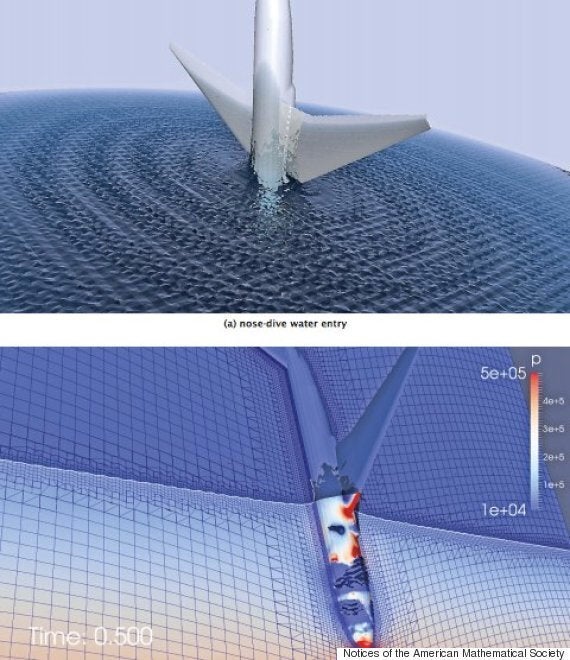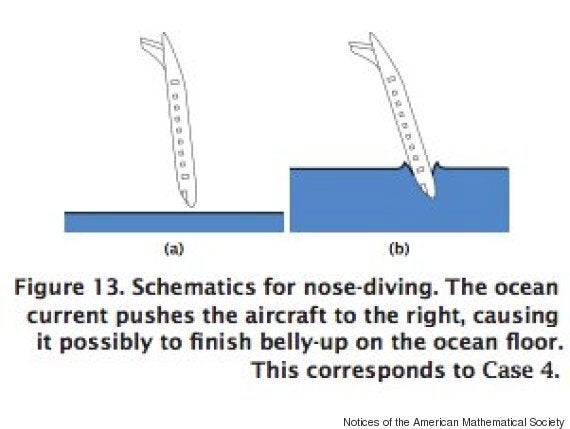A team of academics has come up with a series of complex mathematical formulas in a bid to unravel the mysterious disappearance of Malaysia Airlines flight MH370.
The Beijing-bound Boeing 777 disappeared from radar with all 239 souls on board on 8 March last year, an hour into its departure from Kuala Lumpur.
It is largely assumed to have crashed into the Indian Ocean but no wreckage has been found and this month investigators announced they will not expand the search zone for the missing aircraft.

The team puts the aircraft's 'nose-dive' entry into the water at a pitch angle of −90◦
Theories abound as to what happened to the plane and now experts have created a mathematical model which they believe explains just why no debris has ever been located.
The team, comprising members from Texas A&M, Penn State, Virginia Tech, MIT and the Qatar Environment and Energy Research Institute, was led by Dr Goong Chen and presented its findings in the April 2015 edition of Notices of the American Mathematical Society.
It created five simulation models detailing the various ways the aircraft may have landed in the Indian Ocean [a “water entry problem"].
Among the simulations was a “smooth gliding water entry” as occurred in the case of US Airways Flight 1549, which was landed on the Hudson River by Captain Chelsey Sullenberger in 1999 with no loss of life.

Chesley Sullenberger's safe landing of Flight 1549 in the Hudson River made him a worldwide hero
This was discounted as having occurred with MH370, as “ditching a large airplane on the open Indian Ocean generally would involve waves of height several meters or more, easily causing breakup and the leak of debris.”
The study surmised the most likely scenario was that of a “nose-dive water-entry or a water-entry with a steep pitch angle”.
This theory also surmises that the steep angle is likely to have contributed to preserving the aircraft's fuselage.
It puts the pitch angle of the approaching plane at −90◦, with an angle of approach at 93◦ and assumes the ocean current flows from left to right at a velocity of 2m/sec.

The report adds: “Then, once the aircraft enters the water, the current gradually drives the aircraft towards the 5 o’clock direction. Eventually this could cause it to fall on the ocean floor belly up.”
“If an aircraft stalls in a climb, or if any control surfaces—ailerons, rudder, or stabilizers— malfunction, or if it runs out of fuel and the autopilot stops working (while the pilots are incapacitated or if the action is deliberate), it can fall into a steep nose-dive or even vertical drop."
Upon entry into the water:
“ …The wings and tail would be torn away and the fuselage could reach a depth of 30 meters or 40 meters within seconds, then sink without resurfacing. Wing pieces and other heavy debris would descend soon afterward. Whether buoyant debris from the passenger cabin—things like foam seat cushions, seatback tables and plastic drinking water bottles—would bob up to the surface would depend on whether the fuselage ruptured on impact, and how bad the damage was. 'It may have gone in almost complete somehow, and not left much on the surface,” said Jason Middleton, an aviation professor at Australia’s University of New South Wales.…' This may well offer a powerful clue as to why, so frustratingly, none of the debris of MH370 has been found so far.”
While the team’s research puts this as the most compelling explanation, it concedes: “The mystery of the final moments of MH370 is likely to remain until someday when its black box is found and decoded.”
You can read the full mathematical analysis here.